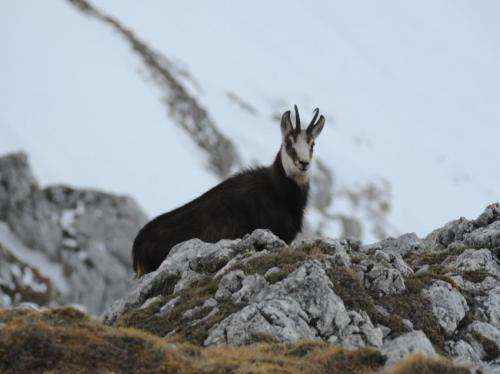Chamois had pneumonia: Cause of death established

In spring 2010, nearly a third of the chamois living in a region of northern Austria suddenly died of unexplained causes. Concerned hunters and foresters sent the carcasses to the University of Veterinary Medicine, Vienna for analysis. Extensive investigations have now revealed that the animals died of bacterial pneumonia caused by two strains of bacteria that are highly unusual in chamois. The results have been published in the Journal of Wildlife Diseases.
Chamois (Rupicapra rupicapra) share their habitat with a number of other wild animals as well as with farm animals. Because of the risk of disease transmission between species, when dead or sick animals are discovered by hunters or foresters it is extremely important determining the causes. Early identification of the cause of disease or death can be crucial to prevent a wide-scale outbreak. The Pathological Laboratory at the Research Institute of Wildlife Ecology specializes in such cases.
Severe pneumonia as cause of death
Nineteen dead chamois from the region of Amstetten, Lilienfeld and Salzburg in north-central Austria were investigated. The researchers performed autopsies, investigating various tissues and testing for the presence of bacteria, viruses and parasites. The analysis revealed that the animals had died of a massive pneumonia.
The causes of the pneumonia turned out to be bacteria with the evocative names Mannheimia glucosida (in honour of the German biologist Walter Mannheim, nothing to do with the German town) and Bibersteinia trehalosi. The bacteria had previously been detected only in cattle and sheep. That they can cause deadly and epidemic pneumonia in chamois was unknown. "It is against the law to administer medical treatment to wild animals, so we don't really have many possibilities to prevent an epidemic", explains Annika Posautz from the pathology team of the Research Institute. "All we can do is try to minimize contact between animals, for example by avoiding the use of salt licks."
There has been no acute die-off of chamois since the cases in 2010. So why were the bacteria so harmful at that time? Posautz believes that "It was probably a combination of several factors. The winter of 2009-2010 was very harsh and the animals were suffering from parasite infestation. The combination of these two factors weakened their immune systems and probably led to the deaths."
Threat to domestic animals
In the Alps, chamois are frequently in close contact with domestic animals such as cattle and sheep that graze in the pastures. This puts farm animals as well as wildlife population at risk for inter-species transmission of infections. Close cooperation with hunters and foresters is essential to ensure that any outbreaks are detected as soon as possible. It is then possible to put emergency measures in place, including increased monitoring of the animals and actions to minimize contact between diseased and healthy individuals.
More information: The article "Acute die-off of chamois (Rupicapra rupicapra) in the eastern Austrian Alps due to bacterial bronchopneumonia with Pasteurellaceae", by Annika Posautz, Igor Loncaric, Anna Kübber-Heiss, Alexander Knoll and Christian Walzer was published in the Journal of Wildlife diseases. DOI: 10.7589/2013-04-090 . www.jwildlifedis.org/doi/abs/10.7589/2013-04-090
Provided by University of Veterinary Medicine -- Vienna















